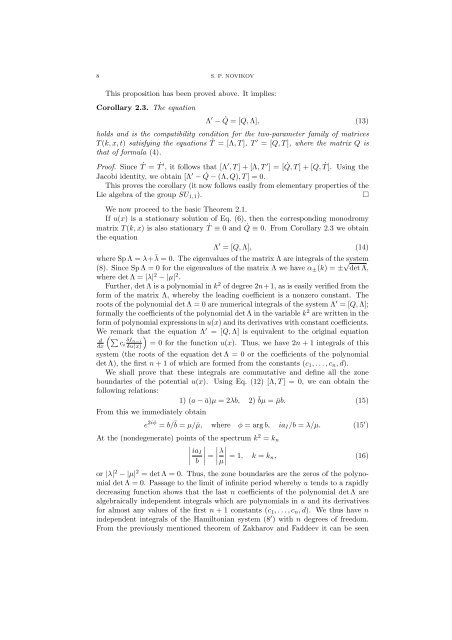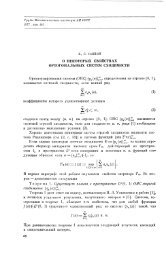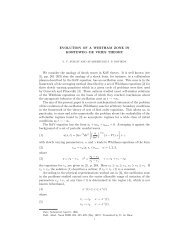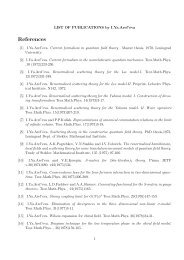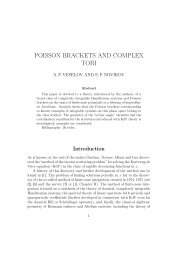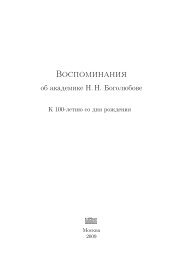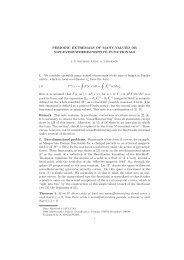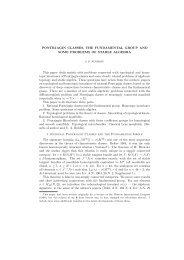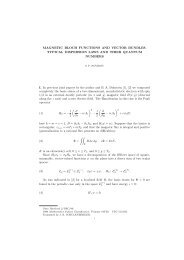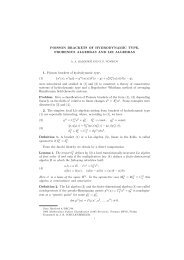A periodic problem for the Korteweg-de Vries equations, I.
A periodic problem for the Korteweg-de Vries equations, I.
A periodic problem for the Korteweg-de Vries equations, I.
Create successful ePaper yourself
Turn your PDF publications into a flip-book with our unique Google optimized e-Paper software.
8 S. P. NOVIKOVThis proposition has been proved above. It implies:Corollary 2.3. The equationΛ ′ − ˙Q = [Q, Λ], (13)holds and is <strong>the</strong> compatibility condition <strong>for</strong> <strong>the</strong> two-parameter family of matricesT (k, x, t) satisfying <strong>the</strong> <strong>equations</strong> T ˙ = [Λ, T ], T ′ = [Q, T ], where <strong>the</strong> matrix Q isthat of <strong>for</strong>mula (4).Proof. Since T ˙ = T ˙ ′ , it follows that [Λ ′ , T ] + [Λ, T ′ ] = [ ˙Q, T ] + [Q, T ˙ ]. Using <strong>the</strong>Jacobi i<strong>de</strong>ntity, we obtain [Λ ′ − ˙Q − (Λ, Q), T ] = 0.This proves <strong>the</strong> corollary (it now follows easily from elementary properties of <strong>the</strong>Lie algebra of <strong>the</strong> group SU 1,1 ).□We now proceed to <strong>the</strong> basic Theorem 2.1.If u(x) is a stationary solution of Eq. (6), <strong>the</strong>n <strong>the</strong> corresponding monodromymatrix T (k, x) is also stationary T ˙ ≡ 0 and ˙Q ≡ 0. From Corollary 2.3 we obtain<strong>the</strong> equationΛ ′ = [Q, Λ], (14)where Sp Λ = λ+¯λ = 0. The eigenvalues of <strong>the</strong> matrix Λ are integrals of <strong>the</strong> system(8). Since Sp Λ = 0 <strong>for</strong> <strong>the</strong> eigenvalues of <strong>the</strong> matrix Λ we have α ± (k) = ± √ <strong>de</strong>t Λ,where <strong>de</strong>t Λ = |λ| 2 − |µ| 2 .Fur<strong>the</strong>r, <strong>de</strong>t Λ is a polynomial in k 2 of <strong>de</strong>gree 2n+1, as is easily verified from <strong>the</strong><strong>for</strong>m of <strong>the</strong> matrix Λ, whereby <strong>the</strong> leading coefficient is a nonzero constant. Theroots of <strong>the</strong> polynomial <strong>de</strong>t Λ = 0 are numerical integrals of <strong>the</strong> system Λ ′ = [Q, Λ];<strong>for</strong>mally <strong>the</strong> coefficients of <strong>the</strong> polynomial <strong>de</strong>t Λ in <strong>the</strong> variable k 2 are written in <strong>the</strong><strong>for</strong>m of polynomial expressions in u(x) and its <strong>de</strong>rivatives with constant coefficients.We remark that <strong>the</strong> equation Λ ′ = [Q, Λ] is equivalent to <strong>the</strong> original equationddx( ∑ciδI n−iδu(x))= 0 <strong>for</strong> <strong>the</strong> function u(x). Thus, we have 2n + 1 integrals of thissystem (<strong>the</strong> roots of <strong>the</strong> equation <strong>de</strong>t Λ = 0 or <strong>the</strong> coefficients of <strong>the</strong> polynomial<strong>de</strong>t Λ), <strong>the</strong> first n + 1 of which are <strong>for</strong>med from <strong>the</strong> constants (c 1 , . . . , c n , d).We shall prove that <strong>the</strong>se integrals are commutative and <strong>de</strong>fine all <strong>the</strong> zoneboundaries of <strong>the</strong> potential u(x). Using Eq. (12) [Λ, T ] = 0, we can obtain <strong>the</strong>following relations:1) (a − ā)µ = 2λb, 2) ¯bµ = ¯µb. (15)From this we immediately obtaine 2iφ = b/¯b = µ/¯µ, where φ = arg b, ia I /b = λ/µ. (15 ′ )At <strong>the</strong> (non<strong>de</strong>generate) points of <strong>the</strong> spectrum k 2 = k n∣ ia I∣∣∣ ∣ b ∣ = λµ ∣ = 1, k = k n, (16)or |λ| 2 − |µ| 2 = <strong>de</strong>t Λ = 0. Thus, <strong>the</strong> zone boundaries are <strong>the</strong> zeros of <strong>the</strong> polynomial<strong>de</strong>t Λ = 0. Passage to <strong>the</strong> limit of infinite period whereby u tends to a rapidly<strong>de</strong>creasing function shows that <strong>the</strong> last n coefficients of <strong>the</strong> polynomial <strong>de</strong>t Λ arealgebraically in<strong>de</strong>pen<strong>de</strong>nt integrals which are polynomials in u and its <strong>de</strong>rivatives<strong>for</strong> almost any values of <strong>the</strong> first n + 1 constants (c 1 , . . . , c n , d). We thus have nin<strong>de</strong>pen<strong>de</strong>nt integrals of <strong>the</strong> Hamiltonian system (8 ′ ) with n <strong>de</strong>grees of freedom.From <strong>the</strong> previously mentioned <strong>the</strong>orem of Zakharov and Fad<strong>de</strong>ev it can be seen


